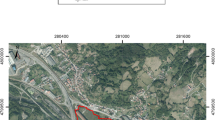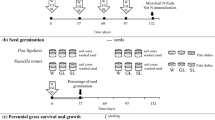Abstract
Finding fast-growing native species able to interfere in invasive grass species’ growth is essential to restore savannas and grasslands, where native tree growth is rather limited. We tested the phytotoxicity of Lepidaploa aurea (Mart. ex DC.) H.Rob. (Asteraceae), a native shrub from the Brazilian savanna that apparently inhibits the growth of invasive grasses in degraded areas and in areas under restoration process. We performed experiments in Petri dishes and soil conditions using four receiver species: three eudicots: Lactuca sativa L., Raphanus sativus L., Solanum lycopersicum L. and a monocot: Sorghum bicolor L. Moench. These are model species commonly used in phytotoxic studies for their known germination rates and high sensitivity to allelochemicals. We tested the effects of aqueous extracts of L. aurea’s leaves and roots, in four concentrations (10, 5, 2.5, 1.25%) and a control (distilled water). We performed tests in natural versus sterilized soils to identify the influence of soil microbiota in L. aurea’s phytotoxicity. We found phytotoxic effects in all tested conditions. Leaf extracts had more accentuated negative effects on target plants than did root extracts. The growth of receiver plants’ root was more affected than shoot growth. Lepidaploa aurea can be an important ally for the restoration of degraded areas savannas and grasslands. Studies considering species that co-occur with L. aurea in conserved and disturbed are as are necessary to confirm this allelopathic potential.


Similar content being viewed by others
References
Anese S, Grisi PU, Jatobá LJ, Pereira VC, Gualtieri SCJ (2015) Phitotoxic activity of different plant parts of Drimys brasiliensis miers on germination and seedling develepment. Biosci J 31:923–933
Atale N, Jaiswal A, Cahhabra A et al (2011) Phytochemical and antioxidant screening of Syzygium cumini seed extracts: a comparative study. J Pharmacol Res 4:4530–4532
Barbosa EG, Pivello VR, Meirelles ST (2008) Allelopathic evidence in Brachiaria decumbens and its potential to invade the Brazilian Cerrado. Braz Arch Biol Tech 51:825–831
Blum U (2011) Plant-plant allelopathic interaction. Springer, Raleig
Cabin RJ, Weller SG, Lorence DH, Cordell S, Hadway RM, Goo D, Urakami A (2002) Effects of light, alien grass, and native species additions on hawaiian dry forest restoration. Ecol Appl 12:1595–1610
Candido ACS, Schmidt V, Laura VA, Faccenda O, Hess SC, Simionatto E, Peres MTLP (2010) Potencial alelopático da parte aérea de Senna occidentalis (L.) Link (Fabaceae, Caesalpinioideae): bioensaios em laboratório. Acta Bot Bras 24:235–242
Castro EA, Kauffman JB (1998) Ecosystem structure in the Brazilian Cerrado: a vegetation gradient of aboveground biomass, root mass and consumption by fire. J Trop Ecol 14:263–283
Chou CH (2006) Introduction to allelopathy. In: Reigosa MJ, Pedrol N, Gonzalez L (eds) Allelopathy: a physiological process with ecological implications. Springer, Dordrecht, pp 1–10
Chung IM, Ahn JK, Yun SJ (2001) Assesment of allelopathic potential of barnyard grass (Echinochloa crus-galli) on rice (Oriza sativa L.) cultivars. Crop Prot 20:921–928
Cummings JA, Parker IM, Gilbert GS (2012) Allelopathy: a tool for weed management in forest restoration. Plant Ecol 213:975–1989
D’Abrosca B, DellaGreca M, Fiorentino A, Monaco P, Previtera L, Simoneti AM, Zarrelli A (2001) Potential allelochemicals from Sambucus nigra. Phytochemistry 58:1073–1081
Durigan G (2008) Bases e diretrizes para a restauração da vegetação do cerrado. In: Kageyama PY, Oliveira RE, Moraes LFD, Engel VL, Gandara FB (eds) Restauração ecológica de ecossistemas naturais. FEPAF, Botucatu, pp 185–204
Durigan G, Guerin N, Costa JMNM (2013) Ecological restoration of Xingu basin headwaters: motivations, engagement, challenges and perspectives. Philos Trans R Soc B 368:1–9
Farias R, Alves ER, Martins RC, Barboza MA, Zanenga-Godoy R, Reis JB, Rodrigues-da-Silva R (2002) Caminhando pelo Cerrado: plantas herbáceo arbustivas, caracteres vegetativos e organolépticos. Universidade de Brasília, Brasília
Ferreira AG (2004) Interferência, competição e alelopatia. In: Ferreira AG, Borghetti F (eds) Germinação: do básico ao aplicado. Artmed, Porto Alegre, pp 251–262
Ferreira AG, Áquila MEA (2000) Alelopatia: uma área emergente da ecofisiologia. Rev Bras Fisiol Veg 12:175–204
Ferreira AG, Borghetti F (2004) Germinação: do básico ao aplicado. Artmed, Porto Alegre
Fowler NL, Simmons MT (2009) Savanna dynamics in central Texas: just succession? Appl Veg Sci 12:23–31
Hegazy AK, Allah EMF (1995) Inhibition of seed germination and seedling growth by Cleome droserifolia and allelopathic effect on rhizosphere fungi in Egypt. J Arid Environ 29:3–13
Holl KD, Howard EA, Brown TM, Chan RG, Silva TS, Mann ET, Russel JA, Spangler NH (2014) Efficacy of exotic control strategies for restoring coastal prairie grasses. Weed Sci Soc Am 7:590–598
James JJ, Drenovsky RE (2007) A basis for relative growth rate differences between native and invasive forb seedlings. Range Ecol Manage 60:395–400
Joo Kim T, Montagnini F, Dent D (2008) Rehabilitating abandoned pastures in Panama: control of the invasive exotic grass, Saccharum spontaneum L., using artificial shade treatments. J Sust For 26:192–203
Kaur H, Kaur R, Kaur S, Baldwin IT, Inderjit (2009) Taking ecological function seriously: soil microbial communities can obviate allelopathic effects of released metabolites. PLoS ONE. doi:10.1371/journal.pone.0004700
Klink CA, Machado RB (2005) A conservação do Cerrado brasileiro. Megadiversidade 1:147–155
Koitabashi R, Kawazu T, Sakai A, Kuroiwa H, Kuroiwa T (1997) 1,8-Cineole inhibits root growth and DNA synthesis in the root apical meristem of Brassica campestris L. J Plant Res 110:1–6
Lankau R (2010) Soil microbial communities alter allelopathic competition between Alliaria petiolata and a native species. Biol Invasions 12:2059–2068
Lima Ribeiro M, Prado E (2007) Distribuição espacial de uma população de Vernonia aurea Mart. ex DC. (Asteraceae) em um fragmento de cerradão no município de Paiapônia, GO. Bras Biosci J 23:81–89
Lopes PG (2016) Alelopatia em Lepidaploa aurea (Asteraceae) como ferramenta de restauração ecológica: potencial para o controle de gramíneas exóticas invasoras no Cerrado. Dissertation. Universidade de Brasília, Brasília
Lorenzi H (2008) Manual de identificação de plantas daninhas: plantio direto e convencional. Plantarum, Nova Odessa
Lovett J, Ryuntyu M (1992) Allelopathy: broadening the context. In: Rizvi SJH, Rizvi V (eds) Allelopathy: basics and applied aspects. Chapman Hall, London, pp 11–19
Muraschin Silva F, Aquila MEF (2006) Potencial alelopático de espécies nativas na germinação e crescimento inicial de Lactuca sativa L. (Asteraceae). Acta Bot Bras 20:61–69
Oliveira SCC, Ferreira AG, Borghetti F (2004) Efeito alelopático de folhas de Solanum lycocarpum A. St.-Hil. (Solanaceae) na germinação e crescimento de Sesamum indicum L. (Pedaliaceae) sob diferentes temperaturas. Acta Bot Bras 18:401–406
Pellizzaro KF (2016) Restauração ecológica por meio de semeadura direta no Cerrado: avaliando espécies de diferentes formas de vida e densidades de plantio. Dissertation. Universidade de Brasília, Brasília
Pivello VR, Shida CN, Meirelles ST (1999) Alien grasses in Brazilian savannas: a threat to the biodiversity. Biodivers Conserv 8:1281–1294
Reigosa M, Gomes AS, Ferreira AG, Borghetti F (2013) Allelopathic research in Brazil. Acta Bot Bras 27:629–646
R Core Team (2015) R: a language and environment for statistical computing. R. Foundation for Statistical Computing, R version 3.2.1 (2015-06-18), São Paulo. http://www.vps.fmvz.usp.br/CRAN/
Sampaio AB, Vieira DLM, Cordeiro AOO et al (2015) Guia de restauração do cerrado, volume 1: semeadura direta. Universidade de Brasília e Rede de Sementes do Cerrado, Brasília
Silva JMC, Bates JM (2002) Biogeographic patterns and conservation in the South American Cerrado: a tropical savanna hotspot the Cerrado, which includes both forest and savanna habitats, is the second largest South American biome, and among the most threatened on the continent. Bioscience 52:225–234
Snedecor GW, Cochran WG (1967) Statistical methods. Iowa State University Press, Ames
SNUC (2000) Sistema Nacional de Unidades de Conservação. Lei no 9.985/2000. http://www.mma.gov.br/areas-protegidas. Accessed 25 Jul 2015
Soares Filho B, Rajão R, Macedo M, Carneiro A, Costa W, Coe M, Rodrigues H, Alencar A (2014) Cracking brazil’s forest code. Science 344:363–364
Srikanth J, Pushpalatha NA (1991) Status of biological-control of Parthenium hysterophorus in India—a review. Insect Sci Appl 12:347–359
Starr CR, Corrêa RS, Filgueiras TS, Hay JV, Santos PF (2012) Plant colonization in a gravel mine revegetated with Stylosanthes spp. in a neotropical savanna. Landsc Ecol Eng 9:189–201
Veldman JW, Buisson E, Durigan G et al (2015) Toward an old-growth concept for grasslands, savannas, and woodlands. Front Ecol Environ 13:154–162
Wagner H, Bladt S (2001) Plant drug analysis: a thin layer chromatograph atlas. Springer, Munich
Young TP, Chase JM, Huddleston RT (2001) Community succession and assembly comparing, contrasting and combining paradigms in the context of ecological restoration. Ecol Restor 19:5–18
Acknowledgements
This study was carried out under ICMBio research permit (46695-1/2015). We thank F. Borghetti, R. Zenni and D. Vieira for suggestions on previous versions of this manuscript and several students from Restaura-Cerrado research group for field and laboratory assistance.
Author information
Authors and Affiliations
Corresponding author
Rights and permissions
About this article
Cite this article
Lopes, P.G., Salles, K.A., Caldas Oliveira, S.C. et al. Evidence of phytotoxicity in a fast-growing shrub useful for savanna restoration in Central Brazil. Braz. J. Bot 40, 643–649 (2017). https://doi.org/10.1007/s40415-017-0381-4
Received:
Accepted:
Published:
Issue Date:
DOI: https://doi.org/10.1007/s40415-017-0381-4




